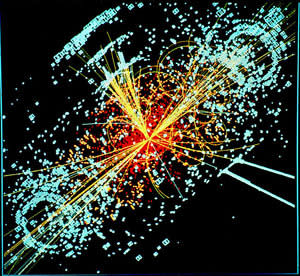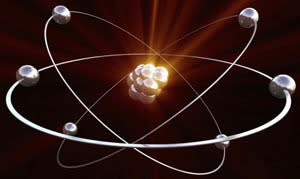 Today in Tech
Today in Tech5 of the biggest unsolved mysteries in physics

The mysteries of the universe are as vast and wide as existence itself. Throughout history, mankind has searched and struggled to find the answers tucked away inside the universe and everything we see around us. As Deep Thought said in the Hitchhiker's Guide to the Galaxy, "I think the problem, to be quite honest with you, is that you've never actually known what the question is."
True, we have yet to come up with the answers to life, the universe, and everything — but oh do we have questions! Solving these mysteries may help to explain not only the creation of the universe, but also how it works, why it works, and possibly how it will end.

1. The Higgs boson
The Higgs boson is a hypothetical particle whose accompanying field is believed to be accountable for giving all other fundamental particles their mass. It is also the only elementary particle theorized in the Standard Model — the closest thing modern physics has to a "theory of everything" — that has not yet been actually observed through experiments. Why the difficulty proving this particular particle's existence? The Higgs boson has such a rapid decay that its appearance in the world is ineffably brief. Instead, physicists look for evidence of the particle's decay itself through experimentation.
The European Organization for Nuclear Research (CERN) has been working to find the elusive particle via experiments at the Large Hadron Collider — the world's largest and most ambitious particle accelerator. By accelerating particles at the LHC to near the speed of light and then smashing them into each other, scientists have recently been able to estimate that they will likely find the signal for the particle somewhere around the mass of 115 to 130 GeV. Now that we know where to look, we're likely to find out sooner than later whether the Higgs boson exists or not — and for physicists around the world, that'll be exciting news either way.
If the Higgs boson does exist, we may finally be able to build a complete picture not only of how the universe works, but why its works the way it does. If it does not exist, the entire scientific community must to go back to the drawing board and begin investigating a new description of our physical universe.

2. Gravity and the mysterious graviton
We've all heard the story of how Newton's observation of an apple falling out of a tree led to his formulation of the law of gravitation. We also know that gravity is the always-attractive force that acts between objects. What you might not know, however, is that gravity is one of the most fundamental yet weakest forces in the universe — so weak, in fact, that the physics world has yet to be able to explain precisely how it works.
Sure, we are quite positive of gravity's existence — drop something and it crashes to the floor, easy enough — but if gravity is a force, according to the Standard Model, it must also have its own accompanying particle. The accompanying particle in question is called the graviton. Gravitons are tiny, massless particles that somehow tug on every bit of matter in the universe. Mysteriously, they are able to do this while being ridiculously weak on the planetary scale yet uncommonly strong in relation to, say, two positively charged protons. We don't know why it acts differently on planets versus elementary particles — heck, we don't even know how to detect them, although we have made various attempts to date.
Since the scientific community has yet to come up with a concrete way to detect the graviton particle, the Laser Interferometer Gravitational Wave Observatory (LIGO) was doing research between 2009 and 2011 to look for wave-like evidence of gravity. Scientists thought they could detect ripples in space-time that are thought to be caused by the acceleration of mass, but by the time the experiment was shut down, they had yet to find anything. There are facilities that have the equipment to continue the experiment, but they are currently focused on solving the Higgs issue. Sadly, even if the Higgs boson is found, it still won't shed much light on the gravity quandaries that still remain.

3. Dark matter
Dark matter is a mysterious sort of glue that not only holds galaxies together but is theoretically responsible for their creation. It was initially hypothesized in 1933 to explain mathematical discrepancies while calculating the mass of galaxies; essentially, more matter is required to hold galaxies together than we can see. Since then, we haven't learned a whole heck of a lot more about dark matter.
In fact, we seem to know more about what itisn't than what it is. We know it isn't antimatter. We also know it isn't dark clouds of normal matter. Many physicists believe that it accounts for about 83% of the matter in the universe — even though we've yet to prove it exists!
The tricky thing with dark matter is that we can't detect it directly; it's invisible. Dark matter only reveals itself through its gravity, so we must instead measure it through its interaction with normal matter. Currently, there are two conflicting experiments being conducted in attempts to confirm the existence of dark matter.
The Cryogenic Dark Matter Search (CDMS) detector at the Soudan Mine in Minnesota is searching for weakly interacting massive particles, or WIMPs, whose discovery could resolve the dark matter problem. Even though dark matter is expected to be everywhere, it is estimated that some WIMPs may pass through an entire galaxy without interacting with any normal matter, making discovery very difficult. Although scientists have not yet detected WIMPs directly, they have found significant evidence that they exist.
In direct conflict with these findings, the experiment XENON100 at the Gran Sasso National Laboratory in Italy has so far yielded only negative results in regards to WIMPs. That isn't to say that WIMPs don't exist, merely that they are harder to detect than scientists had previously presumed.

4. Faster-than-light travel
Admit it — if you've ever watched Han Solo and Chewie take the Millennium Falcon to light speed, or stared in awe the first time you saw the Starship Enterprise jump to maximum warp, you've wanted to see faster-than-light (FTL) travel. Surprising all of us, last year it almost seemed possible. The Oscillation Project with Emulsion-Racking Apparatus (OPERA), another experimental instrument operating at Gran Sasso National Laboratory in Italy, is in part looking at whether or not particles called neutrinos may be able to break this cosmic speed limit.
This highly sophisticated instrument has given results leading some to believe that they have caught neutrinos moving faster than light. A set of neutrinos was sent from CERN's lab in Geneva through the Earth and then observed at the OPERA lab under Sasso Mountain. The entire trip was recorded to have taken under 3 milliseconds, 60 nanoseconds faster than light would have taken.
Needless to say, there are many who have their doubts. Proving faster-than-light travel exists would undermine Albert Einstein's 1905 theory of special relativity, which states that the speed of light (186,282 miles per second, or 671 million miles per hour) is a cosmic constant and that nothing can travel faster than this limit — a cornerstone of our understanding of the universe.
If FTL travel is in fact possible, it opens the door to the possibility of time travel as well. Don't get too excited — there won't be any quick hops to the future in your DeLorean to pick up the next lotto numbers or buy a Gray's Sports Almanac from a local thrift shop. If neutrinos are traveling faster than light, though, they could theoretically arrive somewhere before they departed, so communication to the past may be a possibility. If we could somehow take advantage of this, you could make your alternate past self wealthy by sending a message encoded in neutrinos to invest heavily, for example, in Google stock at the time the company first went public.
But then again, if one can send a message to the past, we must also say goodbye to relativity and causality as we know them. Since cause would no longer need to procede effect, before and after would cease to have meaning. People would retire before graduating from grade school, and eventually, the universe as we know it would cease to be. Speaking of which...

5. How will it all end?
Assuming the standard model is true, our universe's end will likely all come down to one of three theories, each of which depends upon three things: the shape of the universe, how much dark energy is contained within it, and how the densities of dark energy will respond to the expansion of the universe.
There are believed to be three possible shapes of the universe: an open universe, a flat universe, and a closed plane of space-time.
In an open universe (think of a gigantic, saddle-shaped object), the universe is likely to experience the Big Freeze. In this scenario, the universe will continue to expand until matter has stretched incredibly thin, the stars have all burnt out, galaxies have ceased creating new stars to replace them, and all mass as we know it has ceased to exist. Everything will become dark and cold. The universe won't so much as end as it will simply fizzle out, settling into a silent and lonely slumber at absolute zero.
Another possibility for universal armageddon is the Big Rip. Not as dependent on the shape of the universe as much as the amount of dark energy contained within it, this model implies that the acceleration of the universe will continue to increase without slowing, and the dark energy will become so strong that it will overwhelm the other elemental forces. Galaxies, suns, and planets alike will begin tearing themselves apart, all ending in a gravitational singularity — a place in which the standard rules of physics and relativity no longer apply.
Somewhat less unsettling is the theory of the Big Crunch, in which the universe will continue to expand until matter begins to slow the rate of expansion. Once slowed enough, the expansion will eventually come to a halt and begin to retract. Everything — planets, suns, galaxies, black holes, even the indestructible iPad 7000 — will all come crashing back together, culminating in a Big Crunch: essentially the opposite of the Big Bang that kicked our universe off in the first place. The bright side here is that the crunch is thought to be succeeded by yet another Big Bang and the creation of a whole new universe. Unfortunately, of the three, the Big Crunch is currently the least favored hypothesis within the physics community — meaning our dreams of an endlessly cycling universe of birth, destruction, and rebirth may end up being relegated to the realm of science fiction.
[Image credits: David A. Aguilar/Harvard-Smithsonian Center for Astrophysics, Lucas Taylor, Richard Massey/NASA/ESA, Lynette Cook/Gemini Observatory/AURA]
This article was written by Jordan Goodson and originally appeared on Tecca
More from Tecca:
